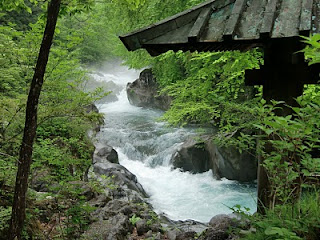
Other than the powerful roar of the water that fed a hydroelectric dam nearby, silence prevailed all around. Not much excitement in this mainly residential part of Nikko. Unused to the absence of human activity, I wondered if I had taken a wrong turn somewhere, and consulted my map once more. Convinced that I hadn't, I continued on, passing by the newer Turtle Bay Inn annex on the right, and after the fifteen minute stroll eventually reached the moss-covered stone figures.

One of the most loved among divinities, jizo statues are considered the guardian deities of children and travelers. This set is called Bakejizo (Deceiving Jizo), based on the myth that no matter how often one counts, the number of jizos always seems to change. (My efforts to keep count went haywire once I started taking photos).
The Bakejizo come in different shapes and sizes ranging from tiny to life-size, perhaps to represent the spirits of both babies and adults. Unfortunately, some statues have been totally destroyed, with only stones or red caps marking their spot.



Even from afar, the red-capped statues make for a pretty sight; my initial impression was that they were either deep in meditation, or were patiently waiting for their meal to be served, red bibs flapping and all. Though most look pretty solemn, bored or asleep, a few had traces of a smile on their faces, as if recalling a fond memory or an inside joke.



I pretty much had the jizo all to myself - the tranquility of the surroundings was calming, yet at the same time scary. I half-expected to be startled by the sound of cracking twigs, human voices, or one of the statues suddenly springing to life at any moment. None of these scenarios came to fruition though. Quite a sharp contrast to the crowds at the temples and shrines I had visited the same morning.
Later, as I consulted assorted travel literature, the Bakejizo were scarcely mentioned at all, and only appear in one map - the same one I had in my pocket, by coincidence. One suspects the jizo, with the sounds emanating from the river their sole accompaniment, prefer it that way.
Check out more Japan posts here.







No comments:
Post a Comment